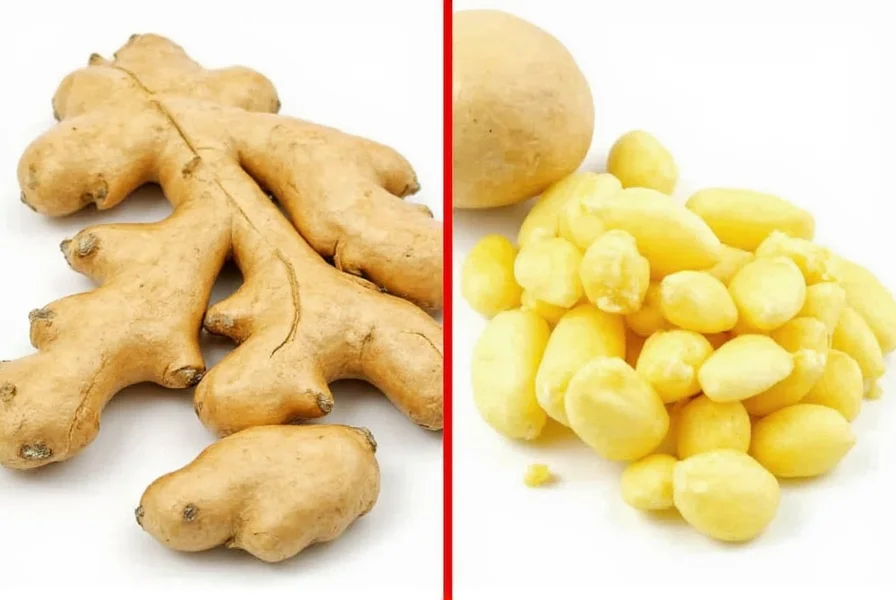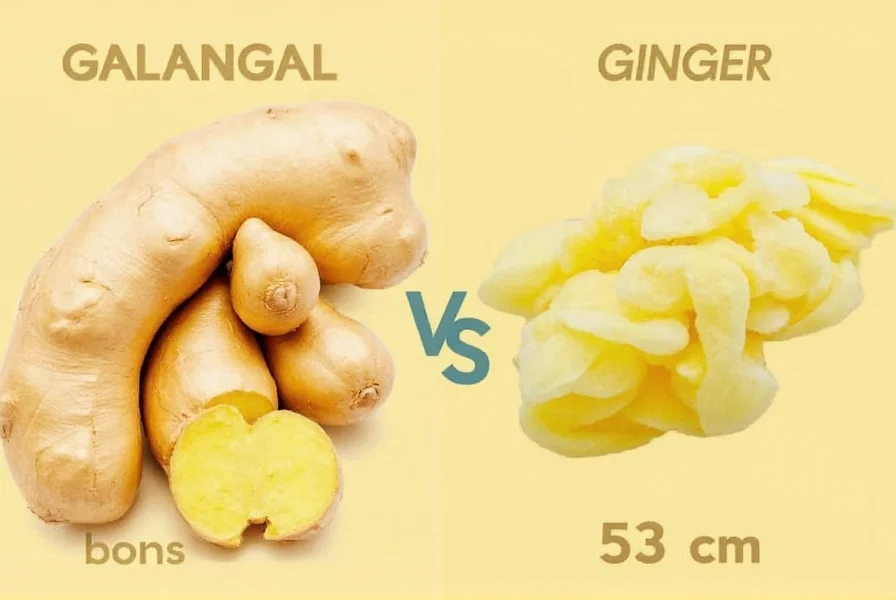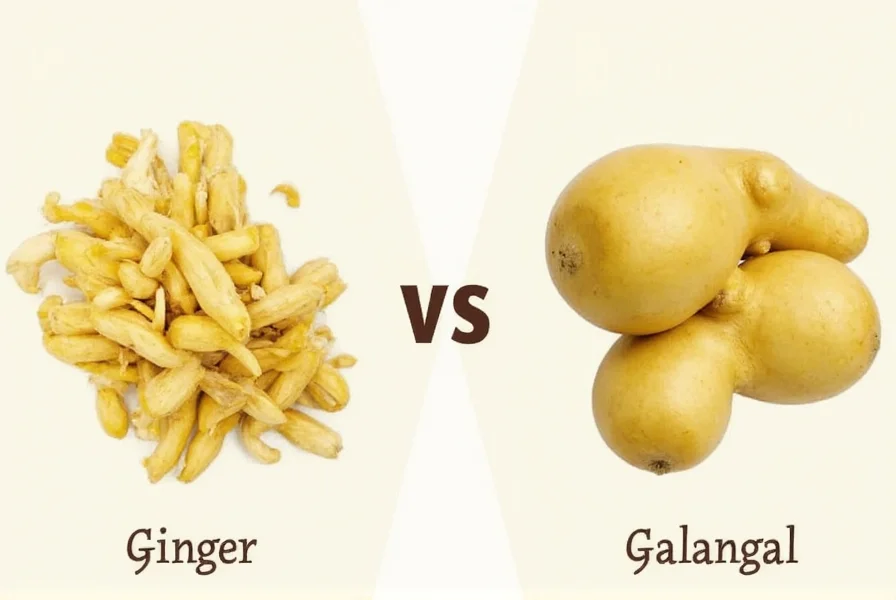When exploring Southeast Asian cuisine or herbal remedies, you'll often encounter two rhizomes that look similar but deliver distinctly different experiences: ginger and galangal. Understanding ginger vs galangal differences is crucial for authentic cooking and maximizing health benefits. While both belong to the Zingiberaceae family, their unique properties make them suitable for different culinary and medicinal applications.
Physical Characteristics: Telling Them Apart
At first glance, ginger and galangal appear similar—both are knobby rhizomes with brown skin. However, closer inspection reveals key distinctions that help with how to identify ginger and galangal.
| Feature | Ginger | Galangal |
|---|---|---|
| Color | Pale yellow interior | Pinkish-white to light orange interior |
| Texture | Moister, more fibrous | Drier, harder, woodier |
| Shape | Plump, smoother knobs | Longer, thinner, more irregular |
| Skin | Thin, easily peeled | Thicker, tougher to peel |

Flavor Profiles: Understanding the Taste Differences
The most significant difference between ginger and galangal lies in their flavor profiles. Ginger delivers a familiar warm, spicy heat with bright citrus notes that mellows when cooked. Its flavor is more rounded and versatile across cuisines.
Galangal, by contrast, offers a sharper, more complex profile with distinct peppery notes, subtle pine undertones, and a citrus flavor reminiscent of lemon or orange rind. It has less of the fiery heat associated with ginger and maintains its flavor intensity better during cooking. This makes galangal particularly valuable in dishes requiring long simmering times, like Thai tom kha gai soup.
Culinary Applications: When to Use Each
Understanding ginger and galangal in cooking helps create authentic dishes. Ginger appears in cuisines worldwide—from Indian curries to Japanese pickles to American gingerbread. Its versatility makes it suitable for both sweet and savory applications.
Galangal remains essential in Southeast Asian cooking, particularly Thai, Indonesian, and Malaysian cuisines. You'll find it in:
- Thai tom kha gai (coconut chicken soup)
- Indonesian rendang (spicy meat stew)
- Malaysian laksa (spicy noodle soup)
While ginger works well in marinades, stir-fries, and baked goods, galangal shines in broths and soups where its distinctive flavor can permeate the entire dish without becoming overpowering.
Substitution Guide: Can You Replace One with the Other?
Many home cooks wonder can I substitute galangal for ginger or vice versa. The answer depends on the recipe:
- Ginger for galangal: Use young ginger (less fibrous) in a 1:1 ratio, but expect a milder, less complex flavor. Works best in soups and broths.
- Galangal for ginger: Use sparingly (½ to ¾ the amount of ginger) as its flavor is more intense. Best in Southeast Asian dishes where authenticity matters.
- For non-Asian dishes: Ginger generally works better as a substitute for galangal than vice versa.
Fresh forms provide the best flavor, but frozen, dried, or powdered versions can work in a pinch. Powdered galangal (often labeled "kha" in Asian markets) works well in curry pastes.
Nutritional and Medicinal Properties
Both rhizomes offer impressive health benefits, though their ginger vs galangal nutritional comparison reveals some differences:
- Ginger: Rich in gingerol, known for anti-nausea properties, digestive aid, and anti-inflammatory effects. Widely studied for motion sickness, morning sickness, and postoperative nausea.
- Galangal: Contains galangin and other compounds with potent antioxidant properties. Traditional medicine uses it for digestive issues, respiratory conditions, and as an antimicrobial agent.
Research suggests galangal may have stronger antimicrobial properties than ginger, while ginger shows more pronounced effects on nausea reduction. Both support immune function, but through different biochemical pathways.
Storage and Preparation Tips
Proper handling affects the ginger and galangal shelf life and flavor retention:
- Storage: Keep both in a cool, dark place. Ginger lasts 2-3 weeks refrigerated; galangal lasts longer (3-4 weeks) due to its drier texture.
- Preparation: Peel ginger easily with a spoon; galangal requires a vegetable peeler or knife due to its tougher skin.
- Cutting: Slice ginger thinly for stir-fries; pound galangal for soups to release maximum flavor.

Common Misconceptions
Several myths persist about these rhizomes. Understanding the true differences between ginger and galangal helps avoid culinary mistakes:
- Myth: Galangal is just another name for ginger.
- Fact: They're distinct plants with different flavor profiles and uses.
- Myth: You can always substitute one for the other 1:1.
- Fact: Substitutions require adjustment due to flavor intensity differences.
- Myth: Galangal is merely "Thai ginger."
- Fact: While used in Thai cooking, it's botanically distinct and has unique properties.
Conclusion
Recognizing the key differences between ginger and galangal elevates your cooking and maximizes health benefits. While ginger offers versatile warmth suitable for global cuisines, galangal provides the distinctive backbone for authentic Southeast Asian dishes. Neither is superior—each has its rightful place in the kitchen. When following recipes, especially from specific cultural traditions, using the correct rhizome makes all the difference in achieving authentic flavor profiles.
Frequently Asked Questions
What's the main difference between ginger and galangal?
The primary difference lies in their flavor profiles. Ginger has a warm, spicy heat with citrus notes that mellows when cooked, while galangal offers a sharper, more complex flavor with peppery notes, pine undertones, and citrus elements. Galangal maintains its flavor intensity better during cooking and has a drier, woodier texture compared to ginger's moister, more fibrous consistency.
Can I substitute galangal for ginger in recipes?
You can substitute galangal for ginger, but with caution. Use about half to three-quarters the amount of galangal compared to ginger, as its flavor is more intense and distinctive. This substitution works best in Southeast Asian dishes where galangal's unique profile is appropriate. For Western recipes or dishes where ginger's specific flavor is essential, the substitution may alter the dish significantly.
Which is better for nausea, ginger or galangal?
Ginger has more scientific evidence supporting its effectiveness for nausea relief, particularly for motion sickness, morning sickness, and postoperative nausea. While galangal also has traditional uses for digestive issues, ginger's active compound gingerol has been more extensively studied for anti-nausea properties. For nausea relief, ginger is generally considered the more reliable option based on current research.
Where can I find galangal if my local grocery store doesn't carry it?
Galangal is commonly available at Asian grocery stores, particularly those specializing in Thai, Indonesian, or Malaysian products. Look for it in the fresh produce section, often labeled as "galangal," "kha" (Thai), or "lengkuas" (Indonesian). If fresh galangal isn't available, check for frozen pieces or powdered galangal in the spice section. Some larger supermarkets with extensive international sections may also carry it, especially in areas with significant Southeast Asian populations.
Does galangal have the same health benefits as ginger?
While both offer health benefits, they differ in their specific properties. Ginger is well-documented for its anti-nausea effects and digestive benefits due to gingerol. Galangal contains different compounds like galangin that provide strong antioxidant and antimicrobial properties. Research suggests galangal may have more potent antimicrobial effects, while ginger shows stronger evidence for nausea reduction. Both support immune function but through different biochemical pathways, making them complementary rather than identical in their health benefits.











 浙公网安备
33010002000092号
浙公网安备
33010002000092号 浙B2-20120091-4
浙B2-20120091-4